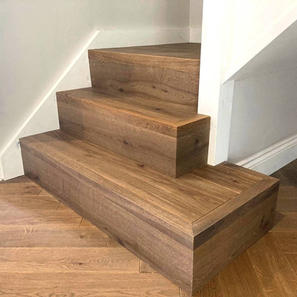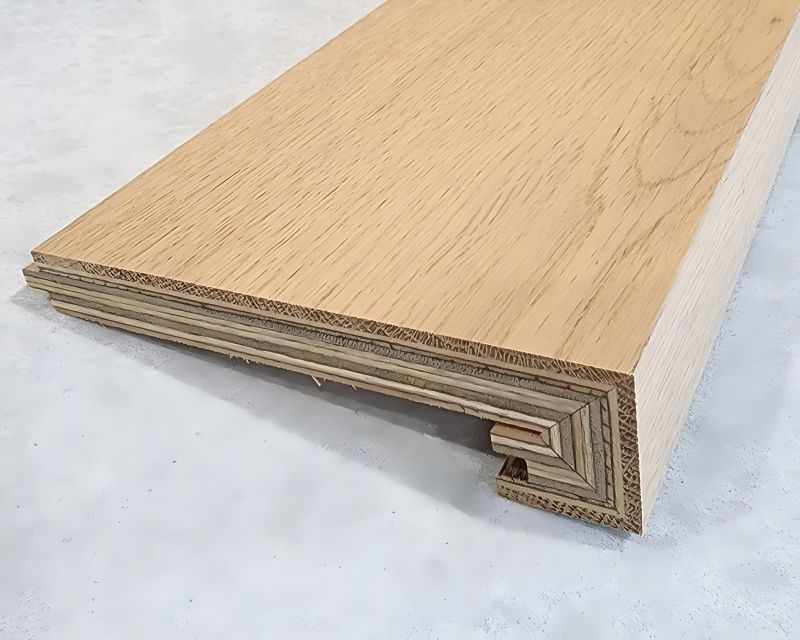The staircase is one place that frequently needs extra care when installing engineered wood flooring. The stair nose sometimes referred to as a stair nosing, is essential to your staircase’s longevity and safety in addition to its appearance.
This essential piece provides a smooth transition between the vertical and horizontal surfaces of the stairs, protects the edges from damage, and ensures a finished look.
In this article, we’ll explore the importance of stair noses for engineered wood flooring, discuss the various types, and provide a comparison table to help you choose the right option for your project.
Table of Contents
ToggleWhat Is a Stair Nose?

A stair nose is a molding or piece of trim that is installed on the front edge of each step in a staircase. Its primary functions include:
- Aesthetic Finish: Stair noses give the stairs a completed, polished look by covering the exposed edges of engineered wood planks.
- Protection: They protect the edges of the wood planks from damage caused by foot traffic or impact, which can otherwise lead to chipping, splintering, or warping.
- Safety: By offering a smooth edge that is easy to see and walk on, stair noses assist lower the chance of trips and falls.
Engineered wood flooring stair noses are available in various shapes and designs, each suited for specific types of stairs and installation methods. These include square edge, bullnose, and overlapping stair noses, each of which has its unique advantages.
Types of Engineered Wood Flooring Stair Nose
There are several different types of stair noses available, depending on your installation method and design preferences. Below is a comparison table summarizing the different types of stair noses:
| Type | Description | Best Use Case | Aesthetic Appearance | Cost |
| Square Edge Nose | Features a straight edge for a clean, modern look | Suitable for flush-mounted stair treads | Sleek, modern, minimalistic | Medium |
| Bullnose Nose | Rounded edge for a softer appearance | Ideal for traditional, curved stair designs | Classic, traditional | Low to Medium |
| Overlapping Stair Nose | Sits slightly over the edge of the wood plank, overlapping the tread | Best for floating floors or click-lock systems | Slightly raised, prominent edge | Medium to High |
| Flush Stair Nose | Creates a seamless, flush transition with the flooring | Suitable for glued or nailed installations | Smooth, seamless | Medium |
| Retrofit Stair Nose | Designed for installation on existing stairs | Works for renovations or retrofitting | Versatile appearance | Medium |
Comparison of Stair Nose Types
Square Edge Stair Nose
One of the newest and most understated designs is a square edge stair nose. It has a clean, sharp edge and makes the transition between the riser and the stair tread smooth. This type of stair nose is ideal for contemporary interiors where clean lines are preferred.
Pros | Cons |
|
|
Bullnose Stair Nose
A bullnose stair nose features a rounded edge, which offers a softer and more traditional look. It is commonly found in houses with more traditional or rustic interior decor.
The rounded edge also makes it more comfortable to step on and can help reduce the appearance of wear on the edge of the stairs.
Pros | Cons |
|
|
Overlapping Stair Nose
An overlapping stair nose is designed to overlap the edge of the wood plank slightly, making it perfect for floating or click-lock engineered wood flooring installations. The raised edge helps cover the expansion gap while maintaining a clean look.
Pros | Cons |
|
|
Flush Stair Nose
Flush stair noses create a smooth, level transition between the stair tread and the riser, providing a sleek, uniform appearance. This type of stair nose is best for floors that are glued or nailed down and creates a professional finish without any raised edges.
Pros | Cons |
|
|
Retrofit Stair Nose
Retrofit stair noses are designed specifically for renovation projects or retrofitting existing stairs. This type of stair nose can be installed on top of existing stair treads, making it a convenient choice for homeowners who want to upgrade their stairs without completely replacing them.
Pros | Cons |
|
|
How to Choose the Right Stair Nose for Your Project
After learning about the many kinds of stair noses, how can you pick the ideal one for installing engineered wood flooring? Here are some things to think about:
Installation Method
The installation method of your engineered wood flooring will heavily influence your choice of stair nose. If you have a floating floor with a click-lock system, an overlapping stair nose will be the best option, as it allows for the expansion and contraction of the wood. If you have glued or nailed flooring, a flush stair nose may offer the cleanest and most professional finish.
Aesthetic Preferences
Think about the general aesthetic you wish to attain in your area. A square edge stair nose offers a modern and minimalistic appearance, while a bullnose stair nose provides a more traditional, classic look. If you want your stairs to blend seamlessly with the rest of your flooring, a flush stair nose is ideal, while an overlapping stair nose will create a more prominent feature.
Durability and Traffic
Durability is crucial because stairs receive a lot of traffic in any house. Square edge and flush stair noses tend to be more durable, especially in homes with heavy foot traffic. Bullnose stair noses are comfortable to walk on but may show wear more quickly over time due to their rounded edge.
Budget
Overlapping stair noses and retrofit stair noses can be more expensive due to their versatility and ease of installation, while bullnose and square edge stair noses tend to be more affordable.
Conclusion
For your engineered wood flooring installation, selecting the appropriate stair nose is crucial to striking the ideal mix between longevity, safety, and aesthetics. The ideal option will rely on your installation technique, preferred style, and financial constraints. Each form of stair nose has special advantages.
By considering the type of flooring, the overall aesthetic of your space, and the traffic level in your home, you can select a stair nose that complements your engineered wood flooring and ensures a long-lasting, professional finish for your stairs. Whether you opt for the sleek look of a square edge stair nose, the classic appeal of a bullnose, or the practical benefits of an overlapping stair nose, your staircase will be both beautiful and functional with the right choice from an engineered wood flooring manufacturer.

